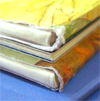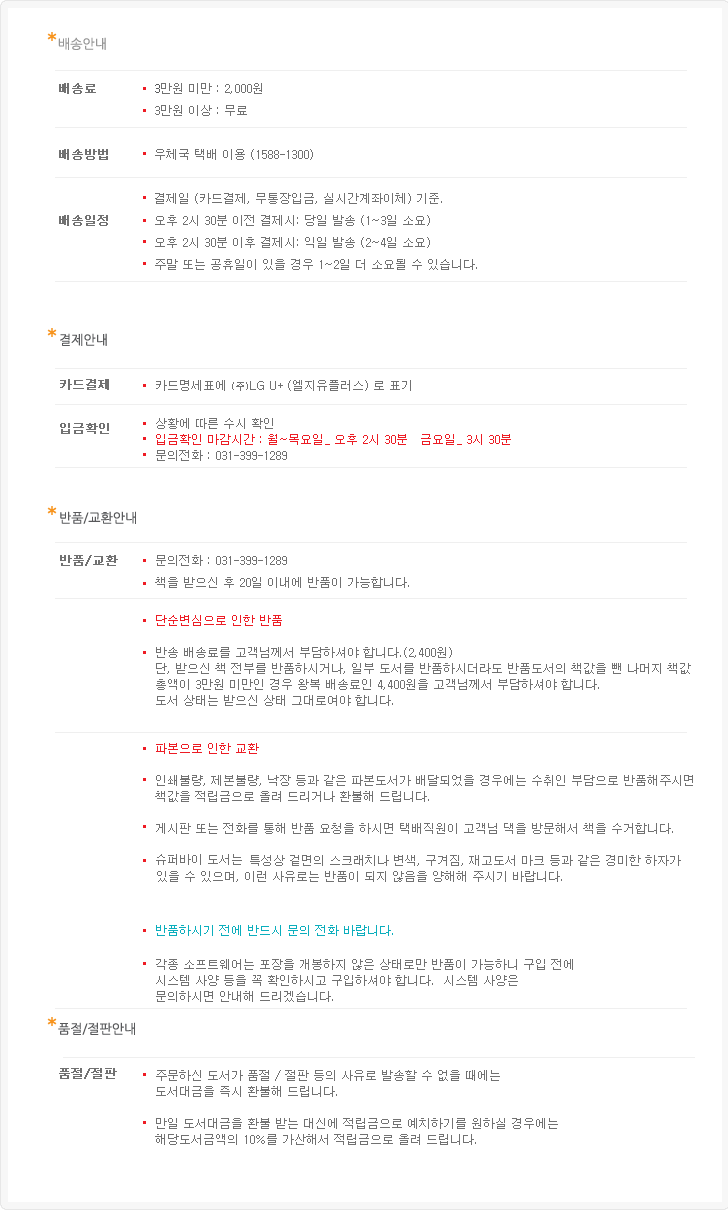|
|
|
|
|
|
|

| 최근 이 책을 구매하신 다른 회원의 책장 |
|
 |
|
|
|
[ 책 소개 ]
Caldecott상을 3차례나 받은 저명한 Illustrator이자 환경에 대해서도 깊은 관심을 갖고 Chattanooga Sludge, My Light 등에 환경보호의 중요성을 깨우치는 작품들을 출간한 Molly Bang의 또 하나의 환경에 관한 그림책입니다.
마을에 공동으로 사용할 수 있는 초지가 있고, 주문들이 이 초치 위에 양을 키운다고 가정을 하면서 이 책은 시작을 합니다. 마을 사람들은 공짜로 양을 최 위에서 키울 수 있기 때문에 경쟁적으로 더 많은 양을 이 초치 위에 풀어 놓지요. 그 결과, 단기적으로는 많은 양을 키우면서 돈을 벌 수 있었지만, 한정된 초지는 곧 황폐화되고, 그 누구도 양을 키울 수 없는 상황이 되지요. 다른 예로는 한정된 바다에서 치어까지 싹쓸이를 하는 고기잡이 방식 때문에 결국은 어족 자원이 고갈이 되고, 한정된 화석연료를 경쟁적으로 캐내서 사용하기 때문에 언제가 화석연료가 고갈이 되면 인류에게 큰 재앙이 닥칠 수도 있지요. 인간의 근시안적인 욕심때문에 산림자원, 수자원 등에도 이런 현상이 일어 나고 있습니다. 작가는 한정된 자원을 무분별하게 사용함으로써 인류에게 닥칠 환경재앙을 보석같이 아름다운 그림과 간결한 문장, 그리고 다양한 예시들을 통해 알기 쉽게 설명해 줍니다.
튼튼한 | 닫기x |  What is 하드커버? What is 하드커버?
양장본이라고도 불리우며, 표지가 단단한 판지로 만들어진 책입니다.
판지를 천이나 가죽으로 감싸기도 합니다. 책의 속지는 일반적으로 중성처리된 종이(Acid-free paper)를 사용해서 잘 변질이 되지 않기 때문에 오랫동안 보관하기에 적합합니다. 이 종류의 책은 더스트 재킷, 또는 더스트 커버로 불리는 표지덮개가 함께 있는 경우가 많습니다. 간혹 내부 속지가 콩기름 코팅이 된 경우 고약한 냄새가 나는 책도 있습니다.
|
[ 서지 정보 ]
Edition : Hardcover: 32 pages
ISBN: 0590100564
책 크기 : 22.8cm x 15.8cm
[ 영문 서평 ]
Annotation
Imagines a village in which there are too many people consuming shared resources and discusses the challenge of handling our world's environment safely.
From the Publisher
A simple story of our planet's natural resources with jewel-like paintings by Caldecott Honor author Molly Bang. Through the example of a shared village green and the growing needs of the townspeople who share it, Molly Bang presents the challenge of handling our planet's natural resources. Full color picture book.
Publishers Weekly
Painted in bright, carefree colors of brilliant ocean blue, lemon yellow and emerald green, this little volume sounds a sober warning about increasing demands on earth's dwindling resources. Bang (Goose) frames the complex contemporary issues of overfishing, deforestation, water pollution and the depletion of fossil fuels within the simpler context of the old village commons. For example, when villagers grazed their sheep on a shared plot, inequity and overcrowding resulted. People with more sheep used more land; and, because it was free, everyone grazed as many sheep as possible. Two responses emerged: some people left to find open land; others remained, setting a limit of one sheep per person and promising "to keep the commons lush and green, and do a better job of sharing it." The colorful patterns of Bang's bustling paintings in full-bleed double-page spreads reveal fish farms, gardens, windmills and solar panels amid the proliferation of industry and machinery. But more subtle is a disturbing arms build-up: as green nature disappears and demands upon the environment compound, guardspointing guns at one anothermultiply. Bang's understated text and subtle illustrations raise important issues about community and the environment, and will leave childrenand adultswith much to think about.
Children's Literature
The importance of environmental preservation is addressed by comparing the water, earth and air we share to sheep and the common ground they graze on. A village built on common ground, owned by everyone in the village, was available for all villagers to bring their sheep to graze. Some villagers owned more sheep than others, but there was no limit on how many sheep an individual could graze. This created problems. To resolve these issues, the people of the town join forces and come up with a plan to share the common ground in a more efficient manor, by limiting the amount of sheep allowed to graze and making every effort to keep the commons in good condition. The story then discusses the problems we face today with over fishing, clear cutting of timberlands, and abusive use of oil, gas, coal and water by everyone. These resources are all common to everyone just as the grass was common to the sheep. This book should make readers stop and think about the importance of working to save the environment and that working together, just as the villagers did with the Commons in the best approach. This book would work well in early elementary science classes. The illustrations are bright, colorful, and present a clear picture of the story being told.
School Library Journal
Bang's small picture book is both simple and ambitious as it presents first a parable and then a string of analogies to raise awareness and provoke thought about the consequences of overusing natural resources. The opening story tells how the green common of a long-ago village quickly becomes overcrowded when too many sheep are sent to graze. Some people decide to stay and work out a plan, but others leave for greener pastures. Bang's paintings employ strong patterns and shades of color, clustering small, crudely sketched figures in naive perspective as the author explains how people today resemble the villagers in using up what they have. "Now our commons are our parks, reserves, and natural resources, and the waters and air of the whole world." She depicts fishermen catching as many fish as possible; lumber companies cutting trees; other companies and individuals using oil and gas and coal; and notes that we all "pump as much of our common water as we can." In each instance there is a short-term benefit and a long-term problem. It's a somber lesson: "One by one, we are destroying the natural resources that sustain our lives." Some scenes suffer from crammed design elements, but others readily command attention. The concluding pronouncement that "now we don't have anyplace else to go" should effectively spark discussion, individual research, and classroom projects.
Kirkus Reviews
Conservation and responsibility for our shared natural resources is the heart of an allegory that inspires respect for the environment, described tidily in simple terms.
Once upon a time, villagers could bring sheep to a commons, "common ground" to everyone in the village. The eventual outcome—too many sheep and not enough grass, provides the historical example that is invoked repeatedly to explain problems and issues arising from present-day overuse of life-sustaining resources and global short-sightedness. Bang (Goose, 1996, etc.) outlines the depletion of the seas, forests, fossil fuels, and water in a series of pithy but easily comprehensible vignettes. Each tenet of basic ecology presented spins on the same axis—the concept of one earth, with limitations as to its renewability; then Bang drives home the "share the planet" precept in a dramatic denouement. Happy greens (grass) and sprightly blues (water, sky) give way to gray rooftops and smokestacks throughout, but it is the lone planet swirling against a canvas of black that is sure to stop readers in their tracks. It's a timely, provocative message, housed in a small, weighty book. |
|
|
|
|
 |
제품상제정보 배송/반품/교환 안내 |
|
|
|
Super Buy 도서는 미국 출판사의 재고도서(Remainder Book), 초과출간도서(Excess Inventory), 할인도서(Bargain Books)
등을 직수입해서 정가의 55%~80%를 할인한 가격에 판매하는 제품입니다.
Super Buy 책의 품질은 거의 새 책과 같은
수준이지만, 간혹 커버의 스크래치나 접힘과 같은 하자나, 책 하단의 재고도서 마크가 있을 수 있습니다.
저렴하게 판매하는 Super Buy 제품의 특성상 반품이 되지 않습니다만, 파본인 경우에는 착불로 반품하시면 책값을
환불해드리거나 적립금으로 올려드립니다. (반품 전에 연락 요망)
하프프라이스북에서는 중고도서(second hand book)를 취급하지 않습니다.
|
|
|
 - 등록된 128,146건의 서평이 있습니다. - 등록된 128,146건의 서평이 있습니다.
| 더보기 
|
|
|
|
|
|
|
 |
|
|
|
|
|
|